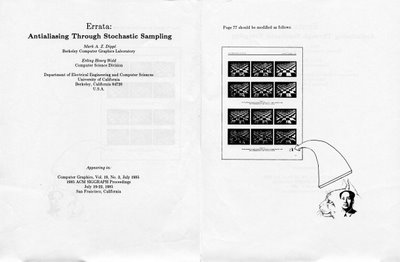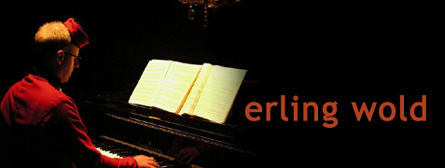
Even time has passed such that we, the belowmentioned, have gone on to our final remuneration or, as it were, our final judgement and, sitting at the hopefully rightmost hand of our omniscient and omnipresent maker, we will have to explain and make right to the throngéd celestial multitudes. Let us further note that the following is absolutely a work of fiction and that any similarities to persons living or dead is purely coincidental, etc.
Anywho, back in graduate school I fell in love (and let us be absolutely clear that this was a higher love - a chaste and perfect love) with a young man who, for want of a better sobriquet, we shall call Mark and who, one day many years later called me to attend the opening of Spawn, whereupon I waited in front of the Kabuki theater with the other unwashed until his limo arrived, spilling him, an assemblage of beautiful young things and a quantity of white powder onto the sidewalk, at which I, his heartbroken friend, was pushed into the gutter by his handlers and so onwards.
But, in my nervous and naive youth, Mark was a dream lover (platonic) and, while he was surely an harbinger of the many evil things to come, I drank deeply, ferociously, from the cup he offered. We were inseparable, sharing everything, making plans for our life together.
Mark was writing a thesis on antialiasing in computer graphics, at the time a fledgling field of study. He came to me one day after reading a paper by Yellot on the Poisson disk distribution of receptors in the eye and wondered if this seemingly haphazard array might have something to do with the lack of aliasing in the human visual system. We thought about it a bit; it made sense, since spectral aliases come from convolution in the frequency domain of the regularly spaced delta functions which are the transform of a regular sampling function. An irregular sampling function would clearly do something quite different, but what exactly? We fretted and suggested and made some mathematical attempts but Mark came across a paper by our savior, our Messiah, the Alpha and Omega man whose name fills the title of this entry: Oscar Aszer Zelig Leneman. Ah, what words, what ideas. We let them flow across us like new buttered honey over a sweet biscuit. In this paper, he laid it all out, a clear approach to determining the spectral noise of a wide variety of stochastic sampling patterns, including the Poisson disk but also many others. We saw how, by engineering the density function, one could improve the results, to spread the noise optimally to areas of minimal sensitivity of the eye, a clear indication of the Gnostic program, the mediocrity of the flawed Demiurgical God of the Old Testament compared to the higher consciousness of man. We found that a simple uniform jitter of the sampling point process by 50% of the mean sampling interval did extremely well. We thereupon danced an ecstatic gambol and wrote our first paper, Antialiasing through Stochastic Sampling, to be published and presented in SIGGRAPH '85 and Mark, in honor and gratitude, changed his middle name to that of our god.
However, as it turned out, another group at Pixar led by Rob Cook had been working on something similar and, as it also turned out, predated us but also, as it happened, had been in communication with Brian Barsky, Mark's ostensible research advisor who had advised them not to publish in SIGGRAPH '85 but rather in his journal, the Association for Computer Machinery's Transactions on Graphics which, he hoped, would replace SIGGRAPH as the Journal Of Record for the field, possibly detracting a bit from the brio and vivacity of the rough and tumble conference scene but lending the field a bit more of the staid orderliness that comes with a proper science. Unfortunately, the staid orderliness of TOG (as it was known to its friends) was chastened by the fact that its production was about a year behind schedule, meaning that their paper would come out so much later than ours as to be embarrassing. When the Pixar folks discovered our paper's imminent arrival - maybe because they were asked to referee, they 'smelled a rat' and assumed that Dr Barsky was 'fucking them over' to favor the advancement of his own soon-to-be newly minted PhD, a possibly not totally unreasonable position given the well-known dog-eat-dog nature of the academy, and they called him and may-or-may-not have explicitly accused him of said conspiracy. Mark and I, obviously, were delighted by the turn of events. A scrap, a brawl, a rumble between our society of distinguished scholars and the korporate brutes outside its containment shield. Hop la! And they were so concerned with it all! While we just saw it as a pleasant diversion. A bit of fun mathematics, a bit of fun programming, a chance to put little animal heads with exposed Brains into the text of our paper and our usual fantastic acknowledgement section with occult holocaust references and fake bibliography (e.g., Crash by J. G. Ballard), tickling the powers above.
And, oh my oh my, those powers above censored one of the brains! To wit, the most beautiful cat brain on page 77 of the proceedings, our coup de théâtre, that which would launch us into the Pantheon of the great minds of our generation. Happy to have our own reason to be incensed, we prepared a volley and launched it against the ACM's so-called Special Interest Group. We printed up a great number of errata sheets, like so:

and passed them out amongst the multitudes of attendees, who dutifully took them and, ah joy of joys, dutifully looked up page 77 and placed them carefully inside, like the great Stalin's replacement of Beria in the Soviet encyclopedias with extended articles on the Bering Sea. We presented our paper to great acclaim, took our bows, and soon the Cook paper, Stochastic sampling in computer graphics, arrived in due course in the January '86 issue of TOG, his feathers having been smoothed by a contrite and ignorance-claiming (the simple truth) Dr "Brain" Barsky.
La la la. That could have been it, but we, suckled as we were on the sweet cream of de Sade, Survival Research Laboratories and the Kipper Kids dancing on broken glass, well, we couldn't just leave it alone, could we? And of course, we had in fact been asked, as the putative experts in the field, to referee the Cook paper, written before ours but oh so joyously presented for publication after, and maybe, just maybe, cleaned up a tiny tad. And we found problems with it. Hoo boy did we. It was hardly up to our fetishistic notions of proper academic-ness. How could it be? In our self-love and self-admiration, we had achieved the pinnacle and the rest of the world lay far below. While our phony bibliography was a work of the highest art, Cook's bibliography had the audacity to reference a Benjamin Franklin paper on magic squares, which they used as stochastic generators with no foundation, none of the mathematical underpinnings of our masterwork, only pictures which "looked good" (and they did look good at that.) We demanded that they reference our paper, being a seminal publication in the field, and we criticized and criticized and gave them low marks as we knew the paper would be published anyway. And wen it finally was a-borned, would we, could we, allow the dead horse to lie unbeaten? No, absolutely not, and we fired off an angry reply to the editor, a brilliantly worded rejoinder which led to a another rebuttal and the fun continued until we finally, our last bit of sperm spent across the face, fell back and slept, the deep and well-deserved sleep of the just and right and meek.
In the end, both papers have been cited quite a bit. We discovered quite happily that Oscar Leneman was a bit of a worldly fellow, having left the engineering profession after publishing the above pictured erotic illustrated fairy tale to deal in South Asian artifacts. Pixar got the patent on stochastic sampling, now expired, which we were once asked to help challenge in court, but declined, having gone on to better things: girls and drugs and Hollywood and the exciting world of The Opera and its ins and outs. Our math was used in textbooks as it was actually correct, but the weird Judeo-Islamo-Christian preoccupation with the one true God and the way He and His angels designed the eye in all its glory still seems to fascinate and lead people to the Poisson disk distribution even though it doesn't work so well and is in general harder to compute. Going up against God and His angels is of course difficult for mortal men, as hard as fighting City Hall, and doesn't really get one girls and drugs so in the end who cares?





2 comments:
This is a tale told better in the triune person of the author's homunculoid self. I laughed, I cried, and then went to IMDB and see that his manifold and serene highness is making direct-to-video Korean Garfield movies. La, indeed.
Yes, I suppose it is better with the gesticulations and the shouting.
Post a Comment